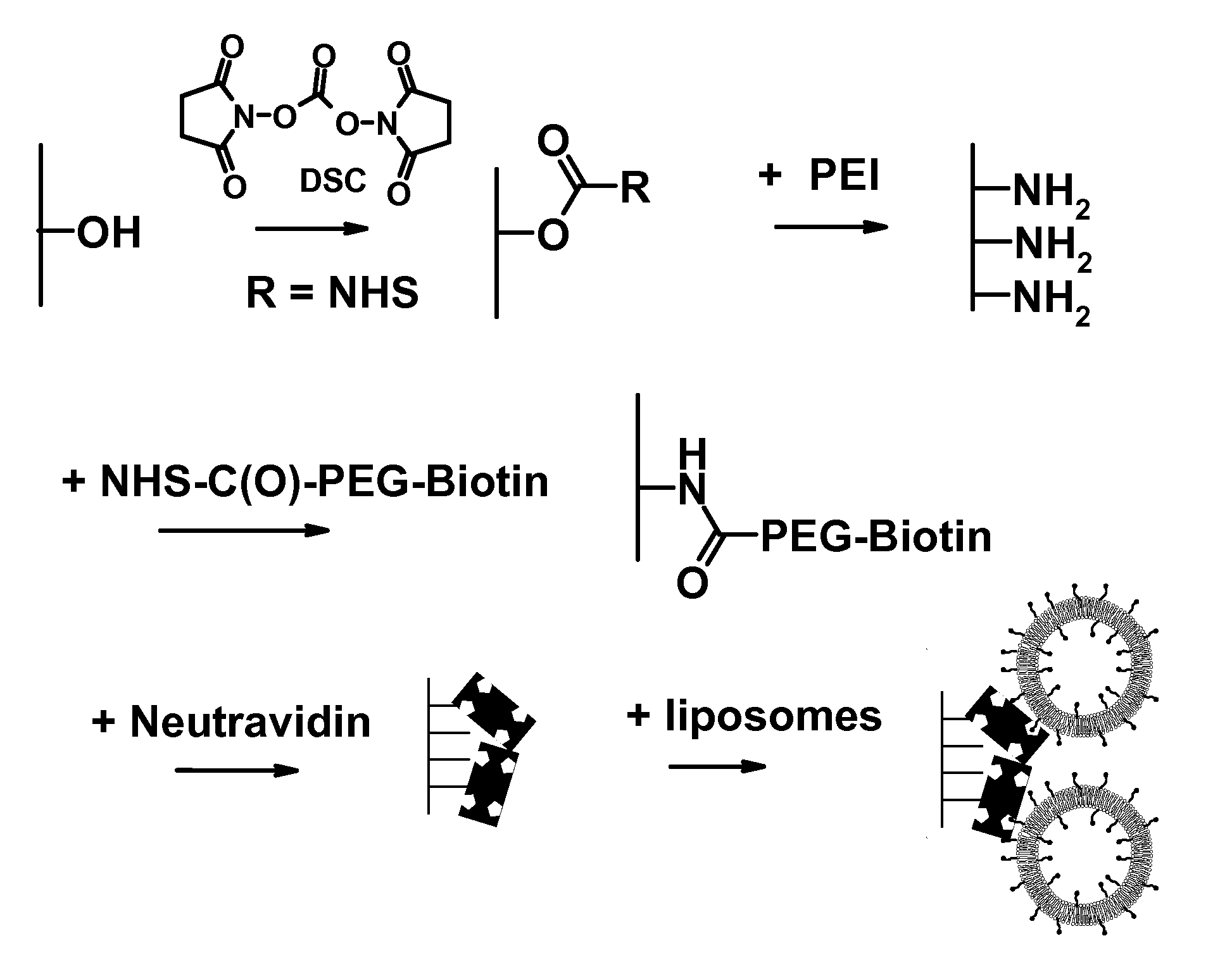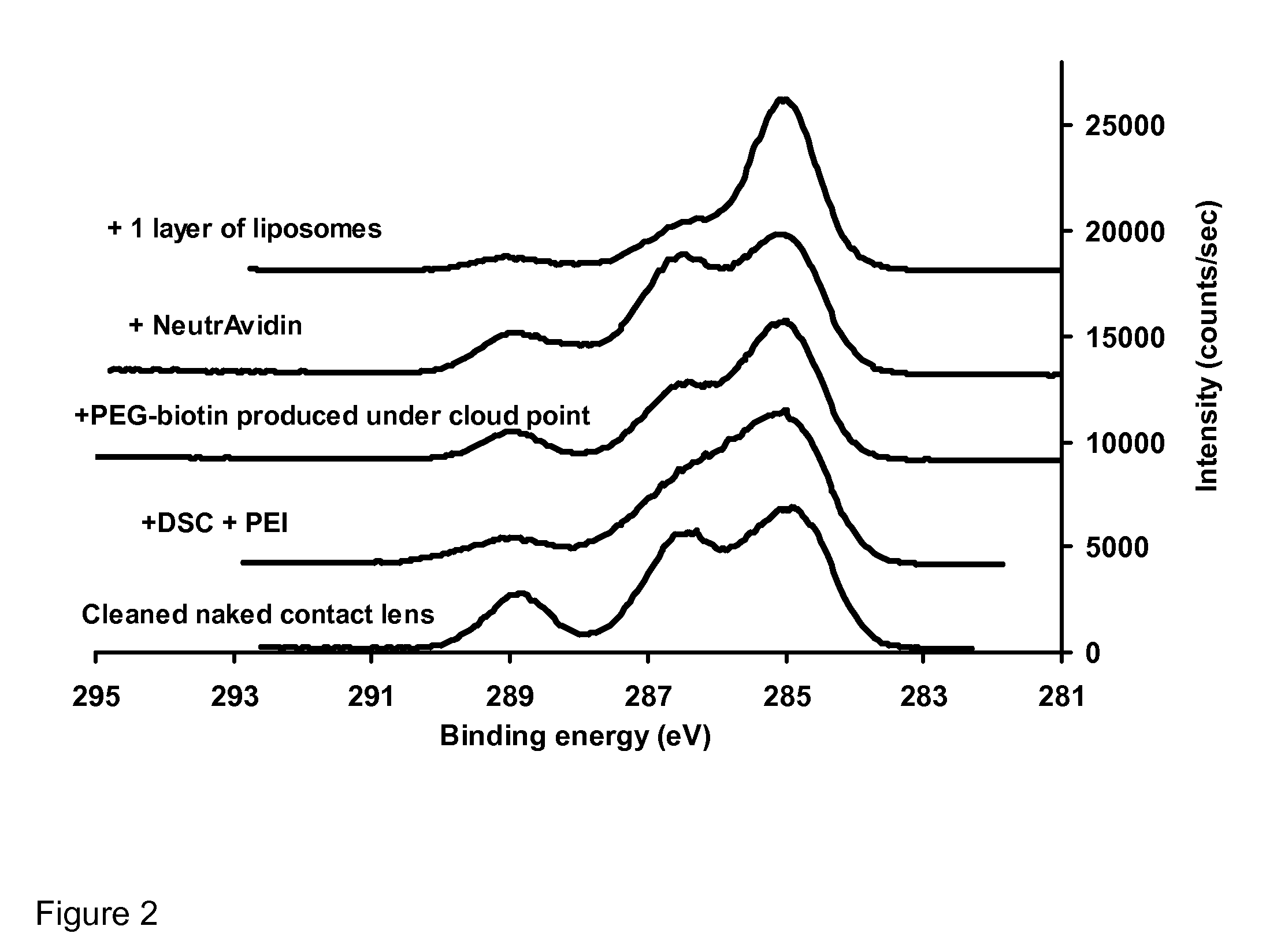Surface-modified materials, such as contact lenses, methods and kits for their preparation, and uses thereof
a technology of surface modification and contact lenses, which is applied in the field of surface modification materials, can solve the problems of optic nerve damage, untreated blindness, and injury to the ocular surface, and achieve the effect of improving wear comfor
- Summary
- Abstract
- Description
- Claims
- Application Information
AI Technical Summary
Benefits of technology
Problems solved by technology
Method used
Image
Examples
example 1
Preparation of Surface Modified Contact Lenses
[0150] Soft contact lenses have been developed as vehicles for ophthalmic drug delivery and / or as biosensors. Drugs or sensing agents are encapsulated in liposomes and then subsequently these intact lipid vesicles are bound onto contact lenses.
[0151] First, polyethylenimine was covalently attached onto the hydroxyl groups available on the surface of a commercial contact lens (Hioxifilcon B). Then, NHS-PEG-biotin molecules were covalently attached onto surface amine groups by carbodiimide chemistry.
[0152] Intact liposomes were immobilized onto the surface of contact lenses using both a monolayer and a multilayer immobilization strategy. To do so, NeutrAvidin protein molecules were bound onto the PEG-biotin layer. Finally, liposomes containing PEG-biotinylated lipids were docked onto the remaining sites of the surface-immobilized NeutrAvidin molecules.
[0153] Multilayers of liposomes were produced by two methods: (1) consecutive additio...
example 2
Antibacterial Activity of Contact Lenses Bearing Surface-immobilized Layers of Intact Liposomes Loaded with Levofloxacin
[0213] In vitro methods for evaluation of antibacterial activity were used with soft contact lenses bearing levofloxacin loaded liposomes developed for the prevention and the treatment of bacterial ocular infection. Levofloxacin was incorporated into liposomes vesicles before these intact liposomes were immobilized onto the surface of soft contact lenses using a multilayer immobilization strategy. The release of levofloxacin from the contact lens into a saline buffer at 37° C. was monitored by fluorescence. The total release of levofloxacin from the contact lens was completed within 6 days. The antibacterial activity of the liposomes coated contact lenses against Staphylococcus aureus was evaluated by measuring the diameters of the inhibition zone on agar and the optical density of the broth. The liposomes coated contact lenses showed an antibacterial activity bot...
example 3
Biocompatibility and Transmission Spectra of Contact Lenses Bearing Surface-Immobilized Layers of Intact Liposomes
[0256] The biocompatibility of soft contact lenses coated with liposomes was evaluated through in vitro direct and indirect cytocompatibility assays. The investigations were performed with epithelial cells from human cornea cultured in monolayers, on reconstructed human corneas, and on ex vivo rabbit corneas since the liposomes attached to the lens will be in direct contact with the external surface of the cornea. Transmittance spectra of these liposome-covered contact lenses were also measured to test whether or not they fulfill their optical function with a minimum of light dispersion or color alteration.
Materials
[0257] Contact lenses (Hioxifilcon B, Opti-Gel 45G, Opti-Centre, Sherbrooke, QC, Canada) were used as substrates for surface immobilization of intact liposomes. All similar lenses had the following parameters: power: −3.00D; total diameter: 14.50 mm; base ...
PUM
| Property | Measurement | Unit |
|---|---|---|
| Fraction | aaaaa | aaaaa |
| Fraction | aaaaa | aaaaa |
| Fraction | aaaaa | aaaaa |
Abstract
Description
Claims
Application Information
 Login to View More
Login to View More - R&D
- Intellectual Property
- Life Sciences
- Materials
- Tech Scout
- Unparalleled Data Quality
- Higher Quality Content
- 60% Fewer Hallucinations
Browse by: Latest US Patents, China's latest patents, Technical Efficacy Thesaurus, Application Domain, Technology Topic, Popular Technical Reports.
© 2025 PatSnap. All rights reserved.Legal|Privacy policy|Modern Slavery Act Transparency Statement|Sitemap|About US| Contact US: help@patsnap.com



